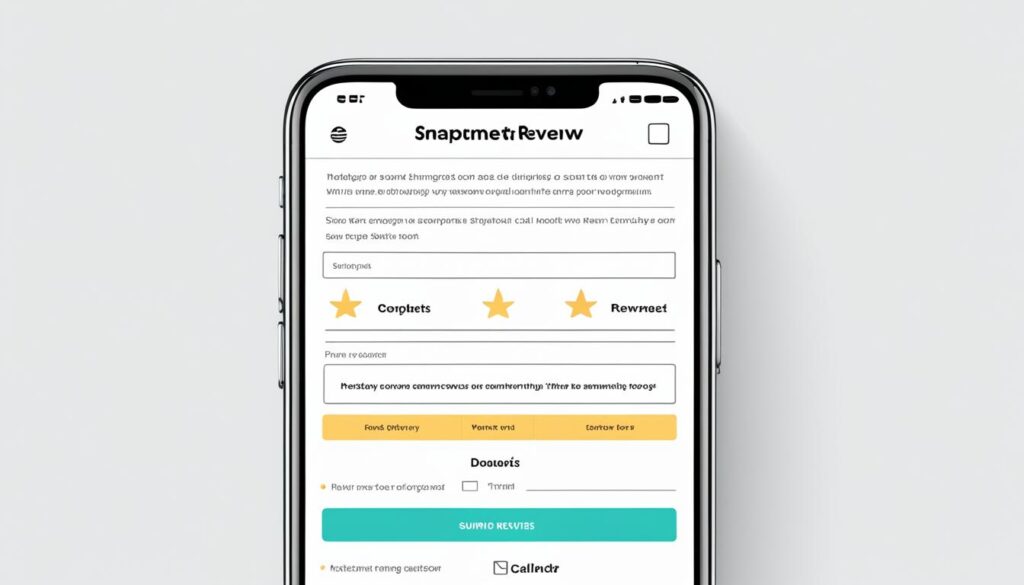Are you missing out on valuable customer feedback by ignoring mobile-friendly review requests? Smartphones and tablets are now our main tools for online chats. We must adjust our plans to fit this mobile world.
Online reviews are key to a company’s good name. In fact, 52% of a company’s worth comes from its reputation1. With 99% of customers reading reviews often when shopping online, reviews can really help or hurt a business1.
It’s vital to get customers to leave reviews to build trust and get more online visibility. A lot of reviews can also help your search engine rankings, making your business more visible online2. But how do we use this chance?
The key is in making review invites for mobile users better. By focusing on mobile-friendly ways, we can get more customer interaction and improve our online image. Let’s see how to use this chance well.
Key Takeaways
- Mobile-friendly review requests are crucial for online reputation management
- Over half of a company’s market value depends on its reputation
- Almost all online shoppers read reviews before making purchases
- Consistent reviews improve search engine rankings and online visibility
- Optimizing for mobile users can significantly boost customer engagement
The Importance of Mobile-Friendly Review Requests
In today’s digital world, making review requests easy for mobile users is key for businesses. Over 50% of the world’s web traffic comes from mobile devices. This shows that making websites mobile-friendly is a must3.
Search engines put mobile-friendly sites at the top of search results. This means businesses need to make sure their review requests work well on mobile4. By focusing on mobile, companies can get better search rankings and get more feedback from mobile users.
Mobile-friendly review requests make it easier for customers to give feedback. A well-designed mobile review platform looks professional and trustworthy. This makes users more likely to leave reviews4. This can lead to more sales and a better online reputation.
“Mobile now accounts for 56% of all website visits, making it crucial for businesses to prioritize mobile-friendly review requests.”
Let’s look at how mobile optimization affects customer feedback and local SEO:
| Aspect | Impact |
|---|---|
| Global Web Traffic | Over 50% from mobile devices |
| Local Search Intent | Significant portion of mobile searches |
| User Expectations | 2-second page load time on mobile |
| Time Spent on Mobile | 4 hours 14 minutes daily average |
By using mobile-friendly review requests, businesses can reach more mobile users. This helps with local SEO and builds a stronger online presence. It also makes search rankings better and builds trust with customers35.
Understanding Mobile User Behavior

Today, mobile devices rule the internet. Almost half of all web visits come from smartphones and tablets. This shows how important it is for businesses to focus on making a great mobile experience6. This change affects how people rate apps, grow their customer base, and what they think of an app overall.
Mobile users act differently than those on computers. They want quick, easy interactions7. To meet this, having a responsive design is key. This means websites should change size to fit any screen7. Doing this makes users happier and can even help with search engine rankings6.
Visuals are key to grabbing mobile users’ attention. Images and videos work well on platforms like Instagram and TikTok7. Also, people often search for local info on their phones, expecting to find what they need quickly7. This shows why local SEO is important for businesses wanting better app ratings and more customers.
To make the mobile app better, think about these things:
- Make sure text is at least 16-point font size for easy reading
- Use sticky elements like fixed navigation menus
- Have clear onboarding for new users
- Offer in-app personalization to increase engagement
By understanding and meeting mobile user needs, businesses can improve their app experience. This leads to better app ratings and a loyal customer base67.
Leveraging SMS and Text Messages for Review Invitations
SMS marketing is now a key tool for businesses wanting to improve their online image. With more people using mobiles, text messages are a direct way to get in touch with customers and ask for reviews.
Text messages are great for asking for reviews. Research shows that 79% of people trust online reviews as much as they trust personal advice, and about 20% will leave a review if asked8. This shows how much people trust what others say online, making SMS a perfect way to get reviews.
Using a specific SMS template with a link to your review site can really boost your response rates. Over 97% of people open text messages within 4 minutes, making it a very active way to get feedback8. This quick action lets businesses get customer thoughts while the experience is still fresh.
Automating SMS for review requests can lead to more sales, better conversion rates, and more loyal customers9. It also saves time and effort, making it easier and bigger in scale9.
“Text messages achieve an open rate exceeding 90%, while email open rates frequently stay at around 20%.”
To make your SMS review invites work best, follow these tips:
- Keep messages short (SMS has a 160-character limit)
- Have a clear call-to-action with a review link
- Use customer data to personalize messages
- Send messages at the right time
Always follow the law, like the Telephone Consumer Protection Act (TCPA) in the U.S., when using SMS for marketing10. Using text messages can really help improve your online image and get valuable feedback from customers.
| SMS Marketing Statistics | Percentage |
|---|---|
| Customers preferring text communication | 90% |
| Text messages opened within 4 minutes | 97% |
| Consumers trusting online reviews | 79% |
| Customers leaving reviews when asked | 20% |
Optimizing Email Review Requests for Mobile
Email marketing is still key for getting customer reviews, but we must adapt for mobile users. With 43% of all email campaigns read on mobile devices, making emails mobile-friendly is crucial11.
To make emails work well on smartphones, focus on key parts. Subject lines should be short, under 30 characters, so they fit on mobile screens12. The preheader text, after the subject line, should be 50 to 100 characters to catch the eye and increase engagement12.

For the email body, use a single-column layout with a width of 500 to 650 pixels to fit most smartphones12. Keep the text simple and use a font size of at least 14 pixels for easy reading12. Include only 1-3 images to make loading times shorter12.
The call-to-action (CTA) button is key for review emails. Make it touch-friendly by making it at least 44×44 pixels12. This makes it easy for users to tap the button to leave a review, even on smaller screens.
“Mobile-friendly emails are no longer optional. They’re a necessity for reaching today’s on-the-go consumers effectively.”
To make your review emails more effective, consider these mobile usage stats:
| Device | Email Open Share |
|---|---|
| Apple iPhone | 38.9% |
| Gmail | 27.2% |
| Apple Mail | 11.5% |
| Outlook | 7.8% |
By making our review emails mobile-friendly, we can boost the chances of getting feedback. About 3 in 5 users check their email on the go, so mobile optimization is key for successful review collection13.
Creating Mobile-Friendly Landing Pages for Reviews

In today’s world, making landing pages for reviews easy to use on mobile is key. With 61% of US visits coming from mobile phones, it’s essential to focus on these devices14. We should aim for pages that load fast and are simple to use on small screens.
A well-made mobile landing page can really help increase conversions. Important parts include a clean design, a clear call-to-action, and fast loading15. For review forms, features like one-click star ratings and short fields make things easier for users.
Here are some tips for making your mobile review form friendly:
- Keep it short: Aim for four questions or less
- Use click-to-call buttons for service-based offerings
- Optimize images for faster loading
- Implement sticky bars to keep the CTA visible
Remember, 30.7% of marketers think four questions is the sweet spot for landing page forms16. By following these tips, we can make a feedback form that works great on any mobile phone.
| Element | Best Practice |
|---|---|
| Layout | Simple and clean |
| Content | Concise and above-the-fold |
| CTA | Clear and prominent |
| Loading Speed | Fast (under 3 seconds) |
Lastly, remember to add trust signals like privacy policy links. Also, use direct links or QR codes to lead customers to your review page. With these steps, we can make the review process smooth and easy for customers.
Timing Your Review Requests for Maximum Impact
Asking for reviews at the right moment can really help. Sending out review invites right after a purchase often gets better responses. This is especially true for items over $100, where customers are 10% more likely to leave feedback.

The best time to ask for a review is when the customer still remembers their experience. For online stores, this means after the product has arrived and been used. Service businesses should wait until after the service is done. Software companies can ask after users have tried new features.
It’s important to avoid asking for reviews during busy times or right after fixing issues. Customers are less likely to respond positively when they’re stressed or upset. Instead, aim for when customers are most happy with their experience.
Personalization is key to getting more reviews. Including the customer’s name and specific order details in your request can boost engagement and response rates17. Remember, 4 in 5 Americans read reviews before making a purchase decision, so each review counts18.
Being consistent with review requests is important. Regular, well-timed invites get better results than random ones. This approach keeps a steady flow of fresh reviews, which is crucial since 69% of consumers view old reviews as not relevant18.
By focusing on timing and personalization, we can make our review requests more effective. This strategy not only boosts our online reputation but also helps potential customers make better choices.
Personalizing Review Invitations for Mobile Users
Making review invitations for mobile users more personal can really help your online image. Adding a personal touch to your requests can lead to more positive feedback from satisfied customers. This method not only gets more people to respond but also builds loyalty among customers who feel appreciated.
Let’s look at some ways to make personalization work. Using customer names and talking about specific purchases can create a bond. For example, “Hi Sarah, we hope you liked your new running shoes!” This makes people more likely to give you a review19.
If you meet customers in person, mentioning the employee who helped them can make a big impact. “John from our tech support team was happy to assist you today. What did you think of your experience?” This shows you care about every interaction.
| Personalization Element | Impact on Review Rates |
|---|---|
| Customer Name | Increases likelihood of response |
| Specific Purchase Reference | Enhances relevance and engagement |
| Employee Mention | Boosts personal connection |
Personalizing your review requests takes more work but usually leads to better reviews. In fact, up to 80% of online reviews come from messages sent after a sale20. This highlights the importance of timely, personalized messages.
About 70% of people will leave a review if asked, and 88% trust online reviews as much as personal advice21. By using personal touches in your mobile review invites, you’re using a strong tool to improve your online image and strengthen customer bonds.
Conclusion
We’ve looked at how important it is to have mobile-friendly ways to ask for reviews. This helps improve your online image and grow your business. Since 95% of people read online reviews and 88% trust them as much as personal advice, feedback matters a lot22. Using smart review management can really help your business stand out and draw in more customers.
Being mobile-friendly is crucial today. We found out that 76% of customers are more likely to leave reviews if asked23. So, using SMS, emails, and easy-to-use pages for reviews is key. These methods, along with the right timing and personal touch, can increase your conversion rate by 31% if you have great reviews22.
Customer feedback is more than just stars. A huge 73% of consumers value review content more than just the ratings22. By asking for detailed, real reviews and using pictures, you can build trust and credibility. Let’s keep using these mobile-friendly ways to make the most of customer reviews. This will help us improve our online image and grow our businesses sustainably.
FAQ
Why are mobile-friendly review requests important?
How do mobile users’ behaviors and preferences differ?
What makes SMS effective for review invitations?
How can email review requests be optimized for mobile?
What are the key features of mobile-friendly landing pages for reviews?
When is the best time to send review requests?
How does personalization impact review request effectiveness?
Source Links
- Online Review Management: Tips, Strategy & Best Practices – https://www.nextiva.com/blog/review-management.html
- LoyaltySurf: Advocacy, Loyalty, and Reward Software (All-in-one) – https://loyaltysurf.io/blog/how-to-get-more-reviews
- Importance of Mobile Friendly Websites: Key to Modern Online Success – Web Upon: Portland SEO, Web Design & Digital Advertising Agency – https://webupon.com/blog/importance-of-mobile-friendly-websites/
- 7 Reasons Your Business Needs a Mobile-Friendly Website | Burlington Press – https://burlingtonpress.com/2023/09/25/7-reasons-your-business-needs-a-mobile-friendly-website/
- Mobile-Friendly or Mobile-First? It’s App vs. Website – Explore What’s Best | Advice Local – https://www.advicelocal.com/blog/mobile-friendly-or-mobile-first/
- The Mobile-Friendly Mindset: How to Create Websites that Prioritize the Mobile Experience – https://www.finalsite.com/blog/p/~board/b/post/mobile-friendly-website
- Understanding Mobile User Behavior – FasterCapital – https://fastercapital.com/topics/understanding-mobile-user-behavior.html
- 15 Strategies to Increase and Get More Google Reviews – https://www.widewail.com/blog/strategies-to-get-more-reviews
- How to Automate Google Reviews With SMS – https://blog.textedly.com/automate-google-reviews-with-sms
- SMS outreach: How to use text messages to engage your clients – https://www.textmagic.com/blog/how-to-use-sms-communication-to-reach-your-clients/
- Mobile-Optimized Emails | Mobile Email Marketing – https://www.pipedrive.com/en/blog/mobile-email-marketing-best-practices
- 6 Tips for Creating Mobile-Friendly Emails – https://www.finalsite.com/blog/p/~board/b/post/6-tips-for-mobile-friendly-emails
- 11 Tips to Optimize Your Mobile-Friendly Email Design – https://www.mailmodo.com/guides/mobile-email-design/
- How to Build a Responsive Landing Page to Get Big Results – https://www.apexure.com/blog/how-to-build-a-responsive-landing-page-to-get-big-results
- 13 mobile landing page examples that seriously set the bar – https://unbounce.com/landing-page-examples/best-mobile-landing-page-examples/
- How to Create a Landing Page with High ROI [Expert and Data-Backed Tips] – https://blog.hubspot.com/marketing/landing-page-best-practices
- How To Ask For Google Reviews Successfully (With Examples) | REVIEWS.io – https://blog.reviews.io/post/how-to-ask-for-google-reviews
- Asking for Reviews from Customers: The Ultimate Guide – https://www.reviewtrackers.com/guides/ask-customers-review/
- 5 Awesome Review Request Email Examples (+ A FREE Template) | REVIEWS.io – https://blog.reviews.io/post/5-awesome-review-collection-email-examples
- 7 Review request templates to text for customer feedback – https://www.textmagic.com/blog/review-request-templates-to-text-for-customer-feedback/
- How to Ask for Google Reviews [Templates Included] | DemandHub – https://www.demandhub.co/articles/how-to-ask-for-google-reviews/
- 17 Positive Review Examples and Response Templates – https://www.demandhub.co/articles/positive-review-examples/
- Clever ways to ask for reviews examples – 30+ copy paste Templets – https://taggbox.com/blog/how-to-ask-reviews/

